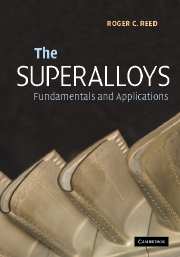Book contents
- Frontmatter
- Contents
- Foreword by Dr Mike Hicks
- Preface
- Acknowledgements
- 1 Introduction
- 2 The physical metallurgy of nickel and its alloys
- 3 Single-crystal superalloys for blade applications
- 4 Superalloys for turbine disc applications
- 5 Environmental degradation: the role of coatings
- 6 Summary and future trends
- Index
5 - Environmental degradation: the role of coatings
Published online by Cambridge University Press: 01 September 2009
- Frontmatter
- Contents
- Foreword by Dr Mike Hicks
- Preface
- Acknowledgements
- 1 Introduction
- 2 The physical metallurgy of nickel and its alloys
- 3 Single-crystal superalloys for blade applications
- 4 Superalloys for turbine disc applications
- 5 Environmental degradation: the role of coatings
- 6 Summary and future trends
- Index
Summary
As with any material, the superalloys suffer chemical and mechanical degradation when the operating temperatures are too high. Obviously the incipient melting temperature of a superalloy represents an upper limit on the temperature that can be withstood; this is usually no greater than about 1600 K. Despite this, the turbine entry temperature (TET) of the modern gas turbine continues to increase, with a take-off value of 1750 K being typical at the turn of this century; see Figure 1.5. Such extreme operating conditions have become possible only because action is taken to protect the components using surface engineering. In fact, the provision of such coatings and measures to ensure that they remain in place during service has become the most critical issue in the gas turbine field; in a state-of-the-art engine the components in the combustor and turbine sections would degrade very quickly were it not for the protection afforded by the coatings placed on them [1]. Thus, whilst the primary role of the superalloy substrate is to bear the mechanical stresses developed, an additional requirement is for mechanical and chemical compatibility with the coatings required to protect them.
Figure 5.1 summarises the different coating technologies which have become available [2,3] and ranks coating life and the temperature enhancement conferred by them in a relative way. It also serves as an introduction to the terminology used. The so-called diffusion coatings remain the most common form of surface protection.
- Type
- Chapter
- Information
- The SuperalloysFundamentals and Applications, pp. 283 - 350Publisher: Cambridge University PressPrint publication year: 2006
- 2
- Cited by



